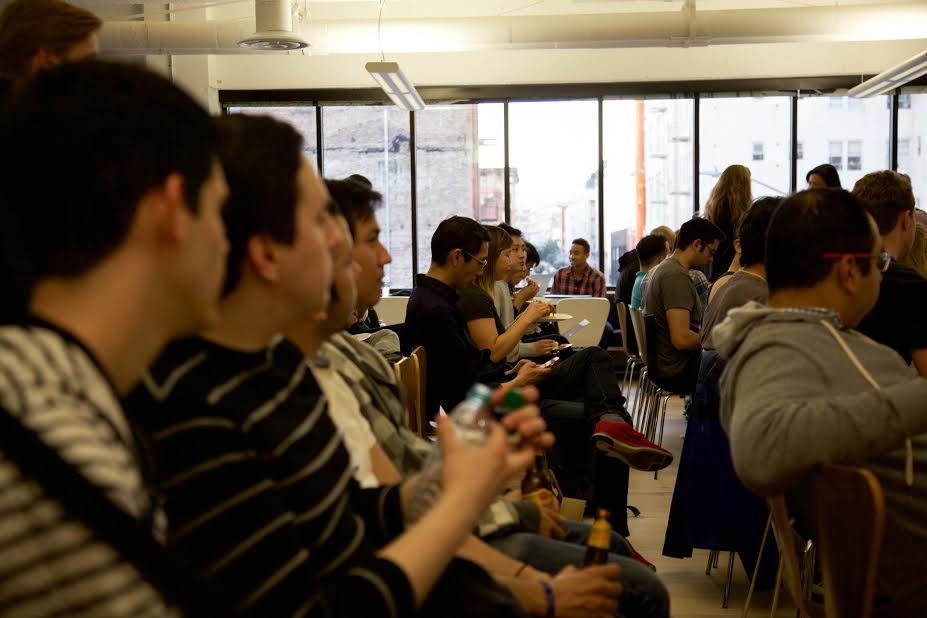What happens when you bring together two sponsors who love building the developer community, four expert panelists, and over 300 mobile growth enthusiasts? Last week wegot an answer to that question at the Mobile Growth Hackers meetup we co-sponsored with Yahoo.
First, we need to thank Yahoo for the part they played. This meetup was the first event of their Mobile Yodel campaign and they did an awesome job of building up the buzz around the event. They also hosted the meetup, inviting participants to their beautiful new offices in downtown San Francisco. The space is fantastic, and cool touches like iPad registration and security escorts to the elevators added to the allure of night, giving this meetup an exclusive feel right from the start.
After working our way through the Flickr -adorned hallways we were met with the energy of hundreds of people eager to learn about the growth hacks that would take their app to the next level as we entered the spacious meetup area. The void created by the quick consumption of pizza and beer was filled with the sound of new and old connections alike. Quickly doing my rounds of the place I came across developers, marketers, salespeople, and even some journalists, all of whom were keen to pick up some new mobile growth strategies.
 A crowd gathers at Yahoo’s headquarters in San Francisco to hear the latest in mobile growth strategy.
A crowd gathers at Yahoo’s headquarters in San Francisco to hear the latest in mobile growth strategy.As 7pm neared, the group was herded towards the main seating area to settle in before the panel discussion began. Sean Galligan, VP of Sales and Business Development at Flurry , was the moderator for the night, and after providing some quick introductions he dove straight into questions.
(The following is a summary of some of the questions and answers from the night. The full audio clip from the night, along with lessons from other mobile growth experts can be found on our podcast channel .)
One challenge we all have is getting users. How do you start from zero? What does that look like?
Bayram Annakov, CEO of App in the Air , a flight tracking and airport assistance app, took the first shot at an answer. In fact, since App in the Air, with over 1,000,000 users, was the smallest company represented, he was quick to answer many of the questions as he related most closely to the audience present. Bayram suggested focusing on three things: app store optimization, the onboarding experience, and visibility. To him, app store optimization is not just about using the keywords that attract people to your app; it’s about explaining what your app is and what it can be used for so that the right people download it. With bad ratings and bad reviews, “you will think your app is bad but you’re really just attracting the wrong audience,” Bayram said. He also believes that explaining your app continues to the onboarding experience: “This is really critical and I like for example how Branch does a customized onboarding experience to improve the probability a user will understand what your app is about and improve the reliability of your app.” On the topic of improving visibility, Bayram suggested making sure you understand who is downloading your app so that you can reach them through the correct channels.
 From left to right, panelists Bayram Annakov, Josh Lu, Mike Burton, Deema Tamimi, and moderator Sean Galligan talk at Branch’s Mobile Growth Hackers Meetup at Yahoo.
From left to right, panelists Bayram Annakov, Josh Lu, Mike Burton, Deema Tamimi, and moderator Sean Galligan talk at Branch’s Mobile Growth Hackers Meetup at Yahoo.Mike Burton, Head of Mobile Engineering at Groupon , and Deema Tamimi, Head of Product Marketing at Flipboard , gave their two cents from the product and marketing side, respectively. Mike, who is also the author of Android App Development for Dummies , suggested focusing on your app’s rating rather than its download count. He recommended building the best product that you possibly can and making sure your users really love and use your product. According to Deema, “you just gotta hustle. If you’re launching your app and starting from zero, a lot of it is just getting really creative.” Deema provided some examples of this type of hustle and creativity, including reaching out to everyone you know and figuring out whether there is a bartering system between another app of a similar size. Once you have some base of users, she said, “it’s about figuring out what people love about your app, and taking those experiences and making them even better.”
Had to step away from #MarchMadness to check out @yahoo‘s #growthhacking meet-up. Great event, @branchmetrics! pic.twitter.com/fUnEHi8DVq
— Ballers Bridge (@BallersBridge) March 27, 2015
On Twitter, #mobilegrowth was used to highlight various parts of the night by meetup attendees.
What are some cool hacks or tricks that you’ve used, invented, borrowed, or heard about?
Bayram took the lead and focused on app ratings for this question. He understands that it is hard to get positive ratings in the app store, but even harder to avoid receiving negative ratings – the ones that can ruin your app. Since the app store doesn’t provide the contact information of users who give you a bad rating, it is typically hard to get in touch with them to ask them what went wrong. Bayram’s clever hack is all about finding the user behind that bad rating:
“Typically the username they use for the app store is the same name they use in other apps and web services. So when we see a particularly negative review we just start Googling and it turns out for example on Ebay you can find the author of this negative review and contact him or her. And actually, most of the time these reviews are coming from users who did not understand what your app was about or just didn’t have enough expertise. So when you approach them you can switch them from negative to positive. Fight the negative reviews.”
Finding negative app reviewers names to contact via eBay = better stalking than a jealous girl on FB. #mobilegrowth @branchmetrics @Yahoo
— April Rosten (@aprilrosten) March 27, 2015
At this point, Josh Lu, Director of Product at Zynga spoke up for the first time about when to prompt a user for a rating. Typically, raters decide to rate the app because they want to give it five stars or one star. Therefore, timing is crucial when asking for reviews: “One thing that we found a Zynga that worked really well on both sides is if someone has a really good experience, say they just won, we’ll prompt them with the rating right then. On the other side, if we know a user crashed recently, we will not show a ratings prompt, no matter what.”
Never show users a ratings prompt if your app had crashed on their device. #mobilegrowth @branchmetrics @yahoo
— Alan Chiu (@alanchiu) March 27, 2015
How have your tactics changed with audience size?
Again, with fresh memories of the 0 to 100,000 download range, Bayram was quick to answer. “During this stage the one thing that you’re obsessed about is the number of downloads. That’s a problems if you have zero engagement or a bad onboarding experience where a user doesn’t understand what the app is about.” App in the Air quickly progressed to caring about onboarding conversion. This led them to provide a “demo flight” to the users who open their app for the first time, since a lot of the users who download their app don’t immediately have a flight coming up. Only once they solved this onboarding problem could they switch their focus to retention, and finally virality.
Mike Burton agreed that there is a tactical shift that takes place as your audience grows. Mike spoke about Groupon’s success using Facebook advertising, but then stated that “you can get to 100,000 users with Facebook advertising. You can maybe get to 1,000,000 users with Facebook advertising. If you want to start getting beyond that, you have to diversify your networks and diversify your exchanges. It’s only through having a lot of different tools that you’re using can you get to the 10 million number.”
Deema mentioned that Flipboard has used the onboarding process to drive user acquisition and retention. Many users come to your app with different experiences of your product, so you can’t think of all your users in the same way. Flipboard found that they could improve their onboarding rate if they did more tailored onboarding for different individuals, and Deema said that “Branch is offering another dimension on that so you can contextualize through shares and that’s super exciting for us since it’s sorta the next step.”
What are the KPI that you use to measure growth effectiveness?
According to Bayram, the important question here is what’s the goal? If your goal is retention, make sure that’s what you measure. He also offered up his $30k advice, “if you do not have the ability to track what’s happening with the user after the user installs the app then you’re throwing money out of the window.”
 There were many noteworthy quotes and tips to take from Thursday’s event.
There were many noteworthy quotes and tips to take from Thursday’s event.Deema echoed Bayram’s response, adding that your metric goals must align with your business goals and with the mission of the company. For Flipboard, this means that metrics are around giving value to users, publishers, and advertisers.
Do you have any tips to converting new users to engaged or paying users?
In response to this question, everyone spoke about looking closely at your app data to test and measure what works. Deema uses app data to find out which people stay on Flipboard longer and what makes them use the app more often. One thing she found especially helpful was in-app education, specifically teaching users to effectively use the part of your app that is most likely to bring them back. Also, if a user hasn’t used the app in a while, prompt them to do so. In one survey, Flipboard found that the number one reason people hadn’t been to the app in over 28 days, was that they basically forgot about it. With so many apps on a user’s phone, simple email reminders can be an effective tool for bringing back old users.
Bayram used data from App in the Air to discover that users who applied promo codes tended to convert 3x higher than the average user. So what was the lesson for him and his team? Give all new users a promo code by default. This simple hack alone led to a 2x overall increased purchased conversion.
Winner of best #mobilegrowth tweet of the night! Congrats @zetongteoh pic.twitter.com/mUU8ulI7xH
— Branch Metrics (@branchmetrics) March 27, 2015
I think what I learned most from this event is that mobile growth is all about being scrappy. Regardless of your funding, or your current number of users, there is always a way to find new users and bring them to your app. In order to retain them, however, you must teach users the value of your app if it is not clear from the start. Throughout the night we saw examples of cheap, dogged growth techniques by companies with millions of users and marketing dollars. If they’re still focusing on clever workarounds for mobile growth, so should you.






















